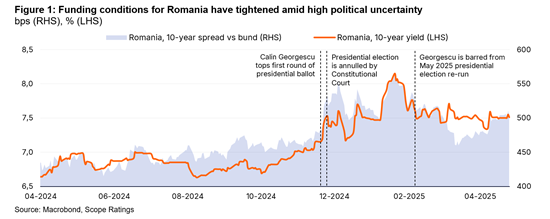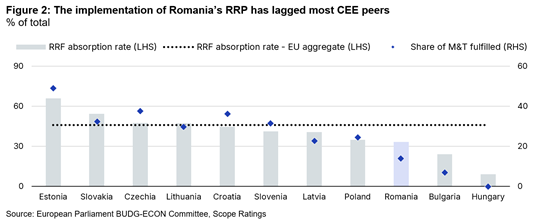Announcements
Drinks

Romania: fiscal pressures rise due to domestic political uncertainty and external risks
By Brian Marly, Sovereign and Public Sector
Domestic political uncertainty and the unfavourable external environment increase the likelihood that Romania (BBB-/Stable) will miss its growth targets of 2.5% in 2025 and 2.9% in 2026, in turn weighing on the plausibility of its fiscal targets.
Under the Excessive Deficit Procedure, launched by the European Commission in 2020 and reaffirmed in 2024, Romania should achieve significant, if gradual, annual reductions to lower the fiscal deficit to below 3% of GDP by 2031 from 8.7% in 2024 (in cash terms). This is the highest fiscal deficit among EU member states, and significantly above those of Hungary (4.9%, BBB/Stable) and Serbia (1.7%; BB+/Positive).
According to the government’s plan, debt-to-GDP would peak at 62.6% in 2029, up from 54.8% in 2024, and decline thereafter, which in our view is optimistic. Our latest estimates, which incorporate expectations of weaker growth in 2025-26 and slower budgetary consolidation, show the debt-to-GDP ratio remaining on a steady increasing trend, concluding our forecast horizon at around 74% by 2030 – doubling from its pre-pandemic level.
Romania’s recent fiscal slippages were driven by inflation-related spending increases and lower-than-expected EU fund disbursement. The government plans to lower the fiscal deficit to 7% of GDP in 2025 primarily through cuts to current expenditure including a freeze on public sector wages and pensions. The budget also assumes strong revenue growth, underpinned by robust real output growth and new taxes.
Domestic political uncertainty weighs on investor confidence and ability to absorb EU funds inflows
Preserving a constructive dialogue and achieving the targets agreed with the European Commission is thus key to Romania’s creditworthiness, as this also ensures continued access to balance-of-payment assistance mechanisms in case of need. These facilities provide a backstop to the country’s external financing, having last been activated in 2009-11 (with additional precautionary programmes over 2011-15), and thus constitute an important rating strength relative to non-EU sovereign peers.
In this context, the outcome of the presidential election next month – with a far-right, nationalist candidate currently ahead in the polls – and the credibility of authorities’ commitment to fiscal consolidation and reform are crucial for Romania’s rating trajectory, as signalled at our last rating review in January.
High political uncertainty, after the previous presidential poll was cancelled on grounds of foreign interference, has weighed on investor confidence and increased government funding costs (Figure 1).

Moreover, the National Bank of Romania’s April decision to leave its policy rate unchanged at 6.5% for the fifth time in a row - amid sticky services inflation, external uncertainty and fiscal pressures - limits prospects for relief in domestic funding conditions in the near term.
Similarly, given the domestic political divisions and the protracted presidential election, progress on achieving EU-milestones has been slow. Romania’s absorption rate for funds allocated under its Recovery and Resilience Facility (RRF) is around 33%, while the government has met only 14% of milestones and targets (Figure 2).

Accelerating reforms is a prerequisite for further disbursements but will likely prove challenging in the near-to-medium term, raising the risk that the government will have to fund projects nationally or cancel them.
As the Next Generation EU programme concludes in August 2026, there are material risks that Romania loses access to a significant portion of its RRF allotment. The Romanian Fiscal Council recently raised similar concerns as regards Cohesion Funds, given low absorption of EU funds tied to the 2021-27 EU budget.
Continued low absorption rates and the potential loss of significant EU funds would impair the medium-term growth outlook, challenging Romania’s fiscal consolidation, and also exacerbate its external sector vulnerabilities given the country’s high current account deficit of 8.4% of GDP in 2024.
Geopolitical uncertainty adds further pressure on the medium-term growth and fiscal outlooks
Given rising geopolitical tensions and the uncertain commitment of the US to support Europe’s security, Romania’s president has said defence spending may need to rise to 3% of GDP by 2027 from around 2.3% in 2024, in line with the new proposed NATO target. We recently estimated that achieving this increase would require additional public funding of around 3.5% of central government revenue.
Finally, the protectionist shift in US trade policy also lowers Romania’s growth prospects. While Romania has limited direct exposure to the US (around 2.5% of total goods exports, less than 1% of GDP), indirect spillover risks arise from its strong ties to the US-exposed, export-driven economies of Germany (AAA/Stable) and Italy (BBB+/Stable), which account for more than 30% of Romania’s exports (about 8% of GDP).
Scope’s next calendar review date is in July 2025.






